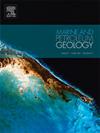川西北地区中二叠统白云岩成因及发育模式
IF 3.6
2区 地球科学
Q1 GEOSCIENCES, MULTIDISCIPLINARY
引用次数: 0
摘要
川西北中二叠统大型白云岩储层的形成与峨眉山大火成岩省(ELIP)重大事件的发生具有良好的时间相关性。但由于白云化流体、白云化时间及白云岩成因机制尚不全面,其发育模式有待进一步分析。本文通过白云岩岩石学特征、碳氧同位素、锶同位素等地球化学资料,以及流体包裹体和激光U-Pb同位素定年,对不同类型白云岩的成岩流体进行了识别。重建了与ELIP动力形成机制相关的白云岩成因模式。川西北地区中二叠统白云岩分为基质白云岩(Md)和胶结白云岩(Cd)。重要的是,基质白云岩包括极细至细晶基质白云岩(Md1),细至中晶基质白云岩(Md2)和中至粗晶基质白云岩(Md3)。白云岩主要经过3期白云化流体的改性。Md1相U-Pb年龄为262±9.2 Ma,与寄主地层年龄一致,87Sr/86Sr比值与二叠纪海水值吻合。这些特征表明Md1主要通过准同生海水回流白云化作用形成。相比之下,Md2相的U-Pb年龄为261.3±7.4 Ma,与地层一致,但含有后期地下胶结物,U-Pb年龄明显为245.7±1.9 Ma。这种明显的年龄偏移表明,Md2是由多个白云化流体相叠加形成的。这些流体主要是由于地热增温作用下的暖地层水与ELIP内的冷海水之间的温差而形成的。斜坡上的冷海水产生流体位能差,产生横向开放环流,引起热对流。Md3和Cd δ18O值呈负偏态,Th和Eu/Eu *值较高,表明成岩流体基本为浅埋地层水,与二叠纪海水相似。它们主要是在ELIP活动期地热温度较高的条件下产生的,产生了较大的流体位能差,并且受更快速的热对流循环驱动。本研究利用激光U-Pb同位素定年技术对白云化时间进行定量约束,旨在为构造活动对大火成岩省白云岩成因的影响提供可靠而有价值的参考。本文章由计算机程序翻译,如有差异,请以英文原文为准。
Genesis and developmental pattern of Middle Permian dolomite in Northwestern Sichuan, China
The formation of large-scale dolomite reservoirs in the Middle Permian of Northwest Sichuan shares a good temporal correlation with the occurrence of major events in the Emeishan Large Igneous Province (ELIP). However, because the dolomitized fluids, the timing of dolomitization and the genesis mechanism of the dolomites are not comprehensively understood, its developmental pattern requires further analysis. This paper identified the diagenetic fluids of different types of dolomites via petrological characteristics of dolomites, carbon and oxygen isotopes, strontium isotopes, and other geochemical data, as well as fluid inclusions and laser U-Pb isotope dating. The dolomite genesis model related to the dynamical formation mechanism of the ELIP was also reconstructed. The Middle Permian dolomites in Northwest Sichuan are divided into matrix dolomite (Md) and cement dolomites (Cd). Importantly, the matrix dolomites include very finely to finely crystalline matrix dolomite (Md1), finely to medium crystalline matrix dolomite (Md2), and medium to coarsely crystalline matrix dolomite (Md3). The dolomites were primarily modified by three phases of dolomitizing fluids. The Md1 phase yields a U-Pb age of 262 ± 9.2 Ma, consistent with the host stratigraphic age, and exhibits 87Sr/86Sr ratios matching Permian seawater values. These features indicate Md1 formed dominantly through penecontemporaneous seawater reflux dolomitization. In contrast, the Md2 phase shows a U-Pb age of 261.3 ± 7.4 Ma—also stratigraphically consistent—but contains later-stage subsurface cements with a distinct U-Pb age of 245.7 ± 1.9 Ma. This significant age offset demonstrates that Md2 resulted from overprinting by multiple dolomitizing fluid phases. These fluids were mainly formed owing to the temperature difference between the warming stratigraphic water and the cold seawater in the ELIP under the geothermal warming effect. The cold seawater on the slope creates a fluid potential energy difference, generating lateral open circulation and causing thermal convection. Furthermore, Md3 and Cd have negatively skewed δ18O values, along with higher Th and Eu/Eu∗ values, suggesting that the diagenetic fluids were substantially shallow buried strata water, which resembled Permian seawater. They were mostly produced under the higher geothermal temperatures during the ELIP active period, which generated a substantial fluid potential energy difference, and were driven by a more rapid thermal convection cycle. This study quantitatively constrains the timing of dolomitization using laser U-Pb isotope dating, aiming to give a reliable and valuable reference for the impact of tectonic activities on dolomite genesis caused by the Large Igneous Province.
求助全文
通过发布文献求助,成功后即可免费获取论文全文。
去求助
来源期刊

Marine and Petroleum Geology
地学-地球科学综合
CiteScore
8.80
自引率
14.30%
发文量
475
审稿时长
63 days
期刊介绍:
Marine and Petroleum Geology is the pre-eminent international forum for the exchange of multidisciplinary concepts, interpretations and techniques for all concerned with marine and petroleum geology in industry, government and academia. Rapid bimonthly publication allows early communications of papers or short communications to the geoscience community.
Marine and Petroleum Geology is essential reading for geologists, geophysicists and explorationists in industry, government and academia working in the following areas: marine geology; basin analysis and evaluation; organic geochemistry; reserve/resource estimation; seismic stratigraphy; thermal models of basic evolution; sedimentary geology; continental margins; geophysical interpretation; structural geology/tectonics; formation evaluation techniques; well logging.
 求助内容:
求助内容: 应助结果提醒方式:
应助结果提醒方式:


